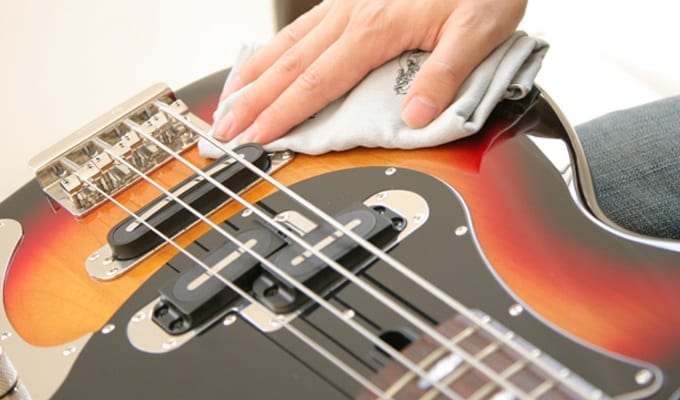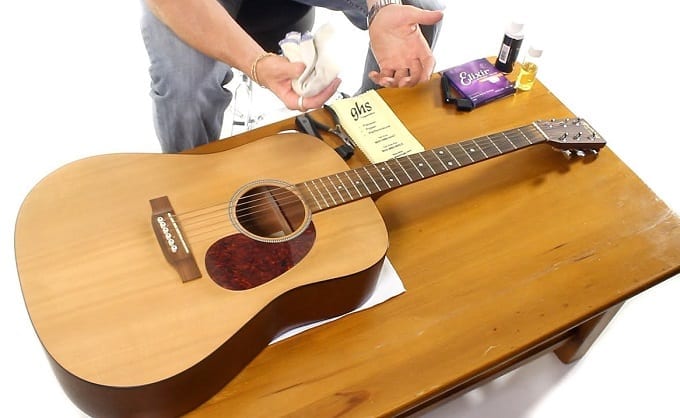A guitar is a major investment and a possession that most people cherish.
Maintaining and safely storing it will ensure that it is able to make sweet music for many years to come.
In this article, we’ll provide you with the complete low-down on how to maintain your beloved guitar.
Contents
Guitar Maintenance Basics
Guitars are relatively sturdy instruments.
They are designed to be used for hours on end, banged around and vigorously strummed. Guitars are not known to wear out.
It’s not like a car where you have to change the oil every so many mile. So long as you follow some common sense maintenance habits, it will keep working for you.
Occasionally, though you may have to replace apart.
Guitars are a little bit like wine in that they actually improve with age. Minor guitar maintenance, such as removing minor or worn parts, can be done by most people.
Cleaning Your Guitar

Every time you take your guitar from its case, inspect it for dust, dirt, and grime.
Dust under the strings on the headstock and bridge of the guitar can be removed with a feather duster.
This is a useful cleaning tool because it removes the dirt without putting any pressure on the surface of the guitar, preventing the possibility of stretching.
Hard to reach spots can be reached with a Q-tip.
Natural oils from your fingers go all over the strings of your guitar every time you play. If you don’t regularly clean them off, they may eventually corrode the strings.
If grime builds upon the strings, this can cause them to go dead sooner than they normally would.
You should wipe down the strings after every session of playing your guitar. The best material to use to clean the strings is a chamois cloth.
You can also use chamois to polish the guitar.
If you don’t have a chamois cloth on hand, and if you happen to have babies in the house, you can also use a diaper cloth – just be sure that it hasn’t been used!
Do not use a handkerchief or a bandana to clean your guitar. They are not absorbent enough.
After you have given each string a general wipe down, then pinch each string between your thumb and index finger (with the cloth held between them).
Now run your hand up and down the entire length of the string.
To clean the wooden part of the guitar, begin by blowing off any dust that may be on the surface.
Then use a dust cloth to wipe over the entire wooden surface. Once the guitar is dust-free you can apply a coat of polish.
Rather than using a furniture polish, which may cause abrasions, you should use a guitar polish which is specifically designed for the task at hand.
When using a guitar polish you should never apply the liquid directly to the surface of your instrument. If you do, you run the risk of staining.
Instead, you should dab the polish onto your cloth and allow it to soak in a little before bringing it into contact with the wooden surface of your guitar.
Some parts of your guitar will prove difficult to reach. These include the headstock and bridge. To do so, you can make use of a camel’s hair paintbrush.
Acoustic Guitar Maintenance

Of you have an acoustic guitar, you will want to maintain the lacquer or synthetic finish.
To maintain the finish, you should be sure that it is dust-free. Keep the guitar out of direct sunlight.
You also want to do your best not to subject the guitar to drastic changes in temperature.
This will help to prevent any cracking from appearing on the surface of the guitar.
If the finish of your acoustic guitar happens to get cracked due to an accident, you should take it to a guitar repair specialist.
Protecting Your Guitar
By nature, a guitar is something that often gets taken out of the home and used in a public setting.
Every time that you travel with your guitar, you should have it in a carry case.
When taking it in your vehicle, you should, if at all possible, sit it in the front passenger seat. Try not put it in the trunk as it may get overheated.
If you have no choice, keep it to the front of the trunk compartment.
When it comes to choosing the carrying case for your guitar, you should always opt for a hardshell case in preference to a soft nylon carry bag.
The hard shell is far more rugged and means that you can stack other things on top of the guitar, which is not the case with a soft bag.
There is a case to be made for nylon carry bags that can be worn over the shoulder.
If you are certain that you will only ever be carrying your guitar over your shoulder, then they will suffice.
When your guitar is being stored at home, keep it in its case. Store it away in a secure place such as under a bed.
There is no advantage to storing the guitar in either a flat or standing position.
You should, however, ensure that it is stored in an environment that is neither too hot or too cold.
The ideal humidity for the health of your guitar is between 45 and 55 percent. This will prevent the problem of swelling that can come with excess moisture.
Your guitar will do well within a temperature range of between 65 and 80 degrees Fahrenheit.
Many people wonder if they should leave their guitar unstrung when it is not being used.
There is no advantage in doing this and it will be quite a hassle to restring every time you want to use the guitar.
However, you should drop the tension down half a step if you know you won’t be using the guitar for an extended period.
This will avoid the problem of causing undue tension to the neck of the guitar, which could cause either swelling or shrinking.
How to Clean Your Guitar Fretboard
The fretboard (or fingerboard) of your guitar is the part that is likely to become the dirtiest.
It’s the contact point between your hands and the surface of the guitar. In order to clean the fretboard, you should first remove all the strings.
This will give you free access to the wood of the fretboard.
Begin by applying a fretboard conditioner (here’s one that we recommend) to the wooden surface of the fretboard.
You can apply a small amount directly to the fretboard. Now use a toothbrush to work the conditioner onto the fretboard.
The final step is to clean the frets themselves. You can use steel wool to do this. With this job done your frets will be clean and sparkling.
Once you have used the toothbrush to work the conditioner into the fretboard, switch over to a soft cloth to clean off any excess.
You can then put the strings back on the guitar.
Conclusion
Guitar maintenance is essential, yet mostly intuitive, part of ownership.
By following the guidelines presented here, you will be able to enjoy the benefits of clean, quality instruments that only gets better with time.


